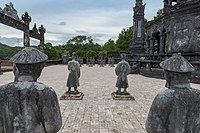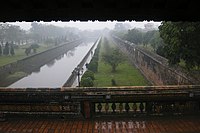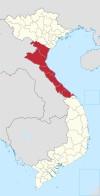Huế
You can help expand this article with text translated from the corresponding article in Vietnamese. Click [show] for important translation instructions.
|
Huế | |
|---|---|
Trường Tiền Bridge | |
| Nickname(s): City of Romance, Festival City | |
 | |
| Coordinates: 16°28′00″N 107°34′45″E / 16.46667°N 107.57917°E 16°28′N 107°35′E / 16.467°N 107.583°E | |
| Country | |
| Region | North Central Coast |
| Area | |
| • Total | 265.99 km2 (102.70 sq mi) |
| Elevation | 15 m (49 ft) |
| Population (2020)[1] | |
| • Total | 652,572 |
| • Density | 2,453/km2 (6,350/sq mi) |
| Climate | Am |
| Website | www.huecity.gov.vn |
Huế (Vietnamese:
Nearly 4.2 million visitors had visited the city in 2019 and many of its historic landmarks are still undergoing restoration.[3]
History

The oldest ruins in Huế belong to the Kingdom of Lâm Ấp, dating back to the 4th century AD. The ruins of its capital, the ancient city of Kandarpapura (lit. 'the city where Śiva burnt Kama'), is now located in Long Tho Hill, three kilometers to the west of the city. Kandarpapura might have only been established during the reign of Kandarpadharma (r. 629–640) and it was named after the king, certainly it may be not the name of the capital of former Lâm Ấp kingdom. Another Champa ruin in the vicinity, the ancient city of Hoa Chau is dated back to the 9th century.
In 1306, the King of Champa,
In 1592, the
Because Mac dynasty loyalists were revolting in Thuan Hoa, and Trinh Kiem was busy fighting the Mac dynasty's forces in northern Vietnam during this time, Ngoc Bao's request was approved, and Nguyen Hoang went south.
The Nguyen lords chose

However,
In 1802, Nguyen Phuc Anh (later Emperor Gia Long) succeeded in establishing his control over the whole of Vietnam, thereby making Hue the national capital.[19]
The second emperor of the Nguyen dynasty to rule from Huế, reigning from his birthday on 14 February 1820 until his death, on 20 January 1841 was

While Bao Dai was proclaimed "Head of the

The city was also the battleground for the
After the war's conclusion in 1975, many of the historic features of Huế were neglected because they were seen by the victorious communist regime and some other Vietnamese as "relics from the feudal regime"; the Communist Party of Vietnam (then Workers' Party of Vietnam) doctrine described the Nguyen dynasty as "feudal" and "reactionary". There has since been a change of policy, however, and many historical areas of the city are being restored and the city is being developed as a centre for tourism and transportation for central Vietnam.

Geography
The city is located in central Vietnam on the banks of the
Located near Trường Sơn mountain range, Huế city is a plain area in the lower reaches of the Perfume and Bo rivers, with an average altitude of 3–4 m above sea level and often flooded when the river's headwaters Hương has medium and large rainfall. This plain area is relatively flat, although there are alternating hills and low mountains such as Ngự Bình mountain and Vong Canh[22] Hill.
Climate
Huế features a tropical monsoon climate (Am) under the Köppen climate classification, falling short of a tropical rainforest climate because there is less than 60 millimetres (2.4 in) of rain in March and April. The dry season is from February to August, with high temperatures of 35 to 40 °C (95 to 104 °F). The rainy season is from August to January, with a flood season from October onwards. The average rainy season temperature is 20 °C (68 °F), although it has fallen as low as 9.5 °C (49.1 °F).[23] The highest temperature recorded was 41.3 °C in May 1983, while the lowest was 8.8 °C in January 1934.
| Climate data for Huế | |||||||||||||
|---|---|---|---|---|---|---|---|---|---|---|---|---|---|
| Month | Jan | Feb | Mar | Apr | May | Jun | Jul | Aug | Sep | Oct | Nov | Dec | Year |
| Record high °C (°F) | 34.6 (94.3) |
36.3 (97.3) |
38.6 (101.5) |
40.6 (105.1) |
41.3 (106.3) |
40.7 (105.3) |
40.2 (104.4) |
40.2 (104.4) |
39.7 (103.5) |
36.1 (97.0) |
35.4 (95.7) |
32.2 (90.0) |
41.3 (106.3) |
| Mean daily maximum °C (°F) | 23.5 (74.3) |
24.5 (76.1) |
27.5 (81.5) |
31.1 (88.0) |
33.5 (92.3) |
34.7 (94.5) |
34.7 (94.5) |
34.2 (93.6) |
31.7 (89.1) |
29.0 (84.2) |
26.5 (79.7) |
23.8 (74.8) |
29.6 (85.3) |
| Daily mean °C (°F) | 19.9 (67.8) |
20.8 (69.4) |
23.1 (73.6) |
26.1 (79.0) |
28.2 (82.8) |
29.3 (84.7) |
29.2 (84.6) |
28.8 (83.8) |
27.1 (80.8) |
25.3 (77.5) |
23.2 (73.8) |
20.7 (69.3) |
25.1 (77.2) |
| Mean daily minimum °C (°F) | 17.5 (63.5) |
18.2 (64.8) |
20.2 (68.4) |
22.7 (72.9) |
24.5 (76.1) |
25.3 (77.5) |
25.2 (77.4) |
25.1 (77.2) |
24.1 (75.4) |
22.8 (73.0) |
21.0 (69.8) |
18.6 (65.5) |
22.1 (71.8) |
| Record low °C (°F) | 8.8 (47.8) |
9.5 (49.1) |
10.7 (51.3) |
14.1 (57.4) |
17.7 (63.9) |
20.5 (68.9) |
19.8 (67.6) |
21.0 (69.8) |
19.1 (66.4) |
15.9 (60.6) |
12.9 (55.2) |
9.5 (49.1) |
8.8 (47.8) |
| Average rainfall mm (inches) | 129.3 (5.09) |
63.3 (2.49) |
51.3 (2.02) |
58.9 (2.32) |
111.3 (4.38) |
103.4 (4.07) |
94.6 (3.72) |
138.8 (5.46) |
410.7 (16.17) |
772.7 (30.42) |
641.7 (25.26) |
349.9 (13.78) |
2,936.4 (115.61) |
| Average rainy days | 15.5 | 11.6 | 10.2 | 9.2 | 11.7 | 9.3 | 8.5 | 10.7 | 16.3 | 20.8 | 20.9 | 20.2 | 165.1 |
| Average relative humidity (%)
|
89.6 | 89.9 | 87.8 | 84.1 | 79.1 | 75.4 | 74.1 | 76.4 | 83.6 | 87.7 | 89.1 | 90.2 | 83.9 |
| Mean monthly sunshine hours | 104.0 | 110.3 | 140.8 | 175.9 | 230.9 | 232.5 | 236.7 | 209.9 | 169.2 | 130.6 | 101.2 | 76.0 | 1,916.1 |
| Source 1: Vietnam Institute for Building Science and Technology[24] | |||||||||||||
| Source 2: The Yearbook of Indochina[25] | |||||||||||||
| Month | Jan | Feb | Mar | Apr | May | Jun | Jul | Aug | Sep | Oct | Nov | Dec | Year |
|---|---|---|---|---|---|---|---|---|---|---|---|---|---|
| Average temperature °C (°F) | 24 °C (75 °F) | 23 °C (73 °F) | 24 °C (75 °F) | 26 °C (79 °F) | 28 °C (82 °F) | 30 °C (86 °F) | 30 °C (86 °F) | 30 °C (86 °F) | 29 °C (84 °F) | 28 °C (82 °F) | 27 °C (81 °F) | 25 °C (77 °F) | 27 °C (81 °F) |
Government

Administrative divisions
Hue comprises 36 administrative divisions, including 29 phường (urban wards):
- An Cựu
- An Đông
- An Hòa
- An Tây
- Đông Ba
- Gia Hội
- Hương An
- Hương Hồ
- Hương Long
- Hương Sơ
- Hương Vinh
- Kim Long
- Phú Hậu
- Phú Hội
- Phú Nhuận
- Phú Thượng
- Phước Vĩnh
- Phường Đúc
- Tây Lộc
- Thuận An
- Thuận Hòa
- Thuận Lộc
- Thủy Biều
- Thủy Vân
- Thủy Xuân
- Trường An
- Vĩnh Ninh
- Vỹ Dạ
- Xuân Phú
and 7 xã (rural communes):
- Hải Dương
- Hương Phong
- Hương Thọ
- Phú Dương
- Phú Mậu
- Phú Thanh
- Thủy Bằng
Culture
In the center of Vietnam, Hue was the royal capital of Vietnam for approximately 150 years (1802–1945),[27] and the royal lifestyle and customs have had a significant impact on the characteristics of the people of Hue. That impact can still be felt today.[citation needed]
Name-giving
Historically, the qualities valued by the royal family were reflected in its name-giving customs, which came to be adopted by society at large.[
Clothing

The design of the modern-day
Thường phục thì đàn ông, đàn bà dùng áo cổ đứng ngắn tay, cửa ống tay rộng hoặc hẹp tùy tiện. Áo thì hai bên nách trở xuống phải khâu kín liền, không được xẻ mở. Duy đàn ông không muốn mặc áo cổ tròn ống tay hẹp cho tiện khi làm việc thì được phép.
Outside court, men and women wear gowns with straight collars and short sleeves. The sleeves are large or small depending on the weather. There are seams on both sides running down from the sleeve, so the gown is not open anywhere. Men may wear a round collar and a short sleeve for more convenience.
This outfit evolved into the áo ngũ thân, a type of five-part costume popular in Vietnam in the 19th and early 20th centuries. Inspired by Paris fashions, Nguyễn Cát Tường and other artists associated with Hanoi University redesigned the ngũ thân to create the modern áo dài in the 1920s and 1930s.[29] While the áo dài and nón lá are generally seen as a symbol of Vietnam as a whole, the combination is seen by Vietnamese as being particularly evocative of Hue. Violet-coloured áo dài are especially common in Huế, the color having a special connection to the city's heritage as a former capital.[30][31]
Cuisine
The cuisine of Huế forms the heart of Central Vietnamese cuisine, but one of the most striking differences is the prominence of vegetarianism in the city. Several all-vegetarian restaurants are scattered in various corners of the city to serve the locals who have a strong tradition of eating a vegetarian meal twice a month, as part of their Buddhist beliefs. Nam Châu Hội Quán is a traditional dining hall. Hue dishes are known for their relatively small serving size with refined presentation, a vestige of its royal cuisine. Hue cuisine is notable for often being very spicy.[32]
Hue cuisine has both luxurious and popular rustic dishes. It consists of several distinctive dishes from small and delicate creations, originally made to please the appetites of Nguyen feudal lords, emperors, and their hundreds of concubines and wives.[33]
Besides
- Bánh bèo is a Vietnamese dish that originally comes from Hue city. It is made from a combination of rice flour and tapioca flour. The ingredients include rice cakes, marinated-dried shrimps and crispy pork skin, scallion oil and dipping source. It can be considered as street food, and can eat as lunch or dinner.
- Cơm hến (baby basket clams rice) is a Vietnamese dish originating in Huế. It is made with baby mussels or basket clams and rice; it is normally served at room temperature.
- Bánh ướt thịt nướng (steamed rice pancake with grilled pork) is the most well-known dish of people of Kim Long- Huế. The ingredients include steamed rice pancake, vegetables – Vietnamese mint herb, basil leaves, lettuce, cucumber and cinnamon leaves, pork and is served with dipping sauce.
- Bánh khoái (Hue shrimp and vegetable pancake) is the modified form of Bánh xèo. It is deep fried and served with Hue peanut dipping sauce containing pork liver. Its ingredients include egg, liver, prawns and pork belly or pork sausage, and carrot. It is served with lettuce, fresh mint, Vietnamese mint, star fruit, and perilla leaves.
- Nguyen dynasty. Main ingredients include tapioca flour, shrimps and pork belly; it is often served with sweet chili fish sauce.
- Banh it ram (fried sticky rice dumpling) is a specialty in Central Vietnam. It is the combination of fried sticky rice dumplings which is sticky, soft and chewy, and crispy stick rice cake at the bottom.
Additionally, Hue is also famous for it delicious sweet desserts such as Lotus seeds sweet soups, Lotus seed wrapped in logan sweet soup, Areca flower sweet soup, Grilled pork wrapped in cassava flour sweet soup, and Green sticky rice sweet soup.
Religion
The imperial court practiced various religions such as Buddhism, Taoism and Confucianism. The most important altar was the Esplanade of Sacrifice to the Heaven and Earth, where the monarch would offer each year prayers to the Heaven and Earth.
In Hue, Buddhism enjoyed stronger support than elsewhere in Vietnam, with more monasteries than anywhere else in the country serving as home to the nation's most famous monks.
In 1963,
Tourism
Thien Mu Pagoda, the largest pagoda in Hue and the official symbol of the city.[37]
A number of French-style buildings lie along the south bank of the Hue High School for the Gifted , the oldest high school in Vietnam, and Hai Ba Trung High School.
 The Vinh Moc tunnels . Most of the hotels, bars, and restaurants for tourists in Hue are located in Pham Ngu Lao, Chu Van An and Vo Thi Sau street, which together form the backpacker district.
In the first 11 months of 2012, Hue received 2.4 million visitors, an increase of 24.6% from the same period of 2011. 803,000 of those 2.4 million visitors were foreign guests, an increase of 25.7%. Although tourism plays a key role in the city's socioeconomic development, it also has negative impacts on the environment and natural resource base.[38] For example, services associated with tourism, such as travel, the development of infrastructure and its operation, and the production and consumption of goods, are all energy-intensive.[39] Research by the Climate and Development Knowledge Network has identified traditional 'garden houses' as having the potential to increase tourist traffic and revenue. Apart from the environmental, economic and cultural benefits provided by garden houses, their promotion could pave the way for other low carbon development initiatives.[40] InfrastructureHuế Railway Station HealthThe Hue Central Hospital, established in 1894, was the first Western hospital in Vietnam. The hospital, providing 2078 beds and occupying 120,000 square meters (30 acres), is one of three largest in the country along with Bach Mai Hospital in Hanoi and Cho Ray Hospital in Ho Chi Minh City, and is managed by the Ministry of Health.[41]
TransportationNorth-South Railway. Phu Bai International Airport is just south of the city centre.
Sister cities
Gallery
See alsoNotesExplanatory notesCitations
External linksWikimedia Commons has media related to Huế. Wikivoyage has a travel guide for Hue.
|
|---|























